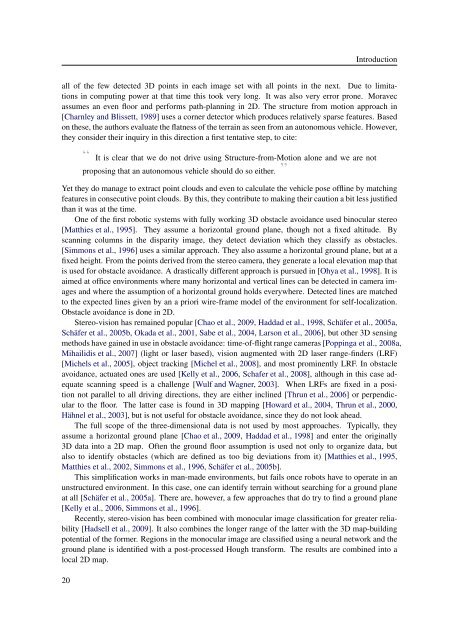PhD Thesis Poppinga: RRT - Jacobs University
PhD Thesis Poppinga: RRT - Jacobs University
PhD Thesis Poppinga: RRT - Jacobs University
You also want an ePaper? Increase the reach of your titles
YUMPU automatically turns print PDFs into web optimized ePapers that Google loves.
Introduction<br />
all of the few detected 3D points in each image set with all points in the next.<br />
Due to limitations<br />
in computing power at that time this took very long. It was also very error prone. Moravec<br />
assumes an even floor and performs path-planning in 2D. The structure from motion approach in<br />
[Charnley and Blissett, 1989] uses a corner detector which produces relatively sparse features. Based<br />
on these, the authors evaluate the flatness of the terrain as seen from an autonomous vehicle. However,<br />
they consider their inquiry in this direction a first tentative step, to cite:<br />
“ It is clear that we do not drive using Structure-from-Motion alone and we are not<br />
proposing that an autonomous vehicle should do so either. ”<br />
Yet they do manage to extract point clouds and even to calculate the vehicle pose offline by matching<br />
features in consecutive point clouds. By this, they contribute to making their caution a bit less justified<br />
than it was at the time.<br />
One of the first robotic systems with fully working 3D obstacle avoidance used binocular stereo<br />
[Matthies et al., 1995]. They assume a horizontal ground plane, though not a fixed altitude. By<br />
scanning columns in the disparity image, they detect deviation which they classify as obstacles.<br />
[Simmons et al., 1996] uses a similar approach. They also assume a horizontal ground plane, but at a<br />
fixed height. From the points derived from the stereo camera, they generate a local elevation map that<br />
is used for obstacle avoidance. A drastically different approach is pursued in [Ohya et al., 1998]. It is<br />
aimed at office environments where many horizontal and vertical lines can be detected in camera images<br />
and where the assumption of a horizontal ground holds everywhere. Detected lines are matched<br />
to the expected lines given by an a priori wire-frame model of the environment for self-localization.<br />
Obstacle avoidance is done in 2D.<br />
Stereo-vision has remained popular [Chao et al., 2009, Haddad et al., 1998, Schäfer et al., 2005a,<br />
Schäfer et al., 2005b, Okada et al., 2001, Sabe et al., 2004, Larson et al., 2006], but other 3D sensing<br />
methods have gained in use in obstacle avoidance: time-of-flight range cameras [<strong>Poppinga</strong> et al., 2008a,<br />
Mihailidis et al., 2007] (light or laser based), vision augmented with 2D laser range-finders (LRF)<br />
[Michels et al., 2005], object tracking [Michel et al., 2008], and most prominently LRF. In obstacle<br />
avoidance, actuated ones are used [Kelly et al., 2006, Schafer et al., 2008], although in this case adequate<br />
scanning speed is a challenge [Wulf and Wagner, 2003]. When LRFs are fixed in a position<br />
not parallel to all driving directions, they are either inclined [Thrun et al., 2006] or perpendicular<br />
to the floor. The latter case is found in 3D mapping [Howard et al., 2004, Thrun et al., 2000,<br />
Hähnel et al., 2003], but is not useful for obstacle avoidance, since they do not look ahead.<br />
The full scope of the three-dimensional data is not used by most approaches. Typically, they<br />
assume a horizontal ground plane [Chao et al., 2009, Haddad et al., 1998] and enter the originally<br />
3D data into a 2D map. Often the ground floor assumption is used not only to organize data, but<br />
also to identify obstacles (which are defined as too big deviations from it) [Matthies et al., 1995,<br />
Matthies et al., 2002, Simmons et al., 1996, Schäfer et al., 2005b].<br />
This simplification works in man-made environments, but fails once robots have to operate in an<br />
unstructured environment. In this case, one can identify terrain without searching for a ground plane<br />
at all [Schäfer et al., 2005a]. There are, however, a few approaches that do try to find a ground plane<br />
[Kelly et al., 2006, Simmons et al., 1996].<br />
Recently, stereo-vision has been combined with monocular image classification for greater reliability<br />
[Hadsell et al., 2009]. It also combines the longer range of the latter with the 3D map-building<br />
potential of the former. Regions in the monocular image are classified using a neural network and the<br />
ground plane is identified with a post-processed Hough transform. The results are combined into a<br />
local 2D map.<br />
20
















